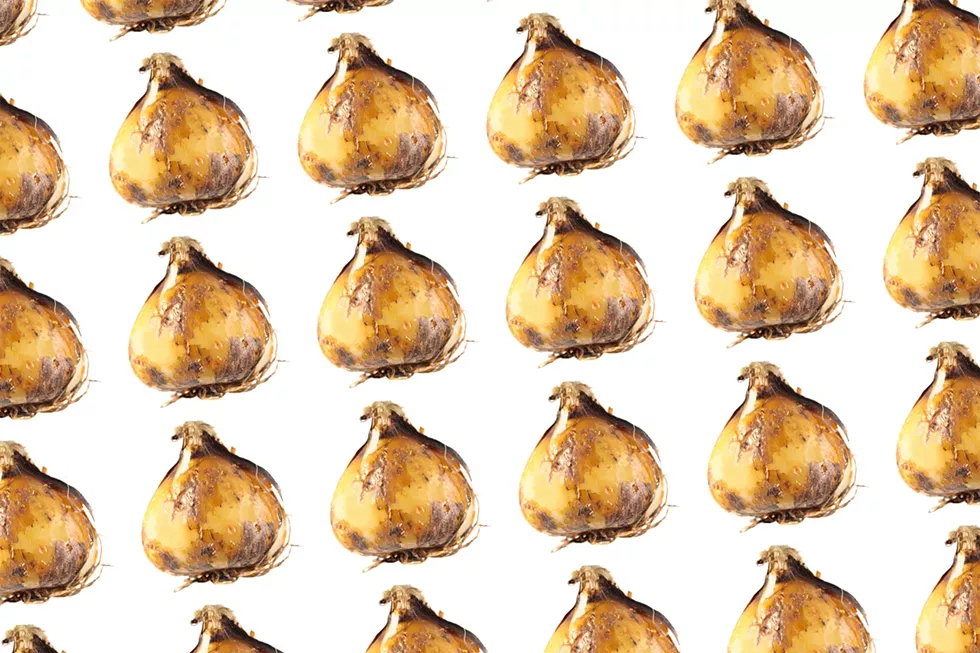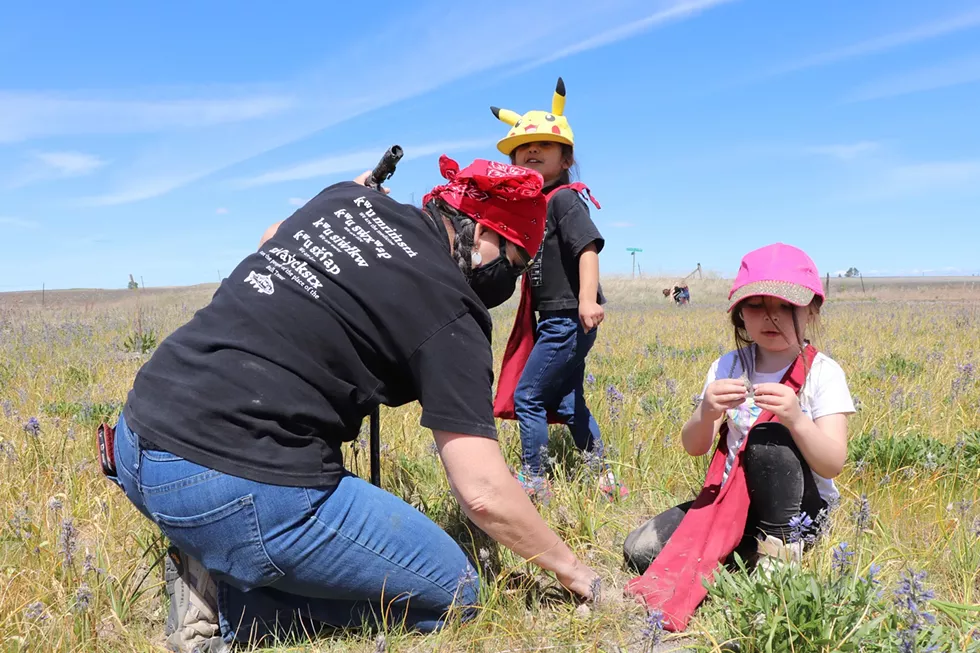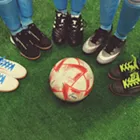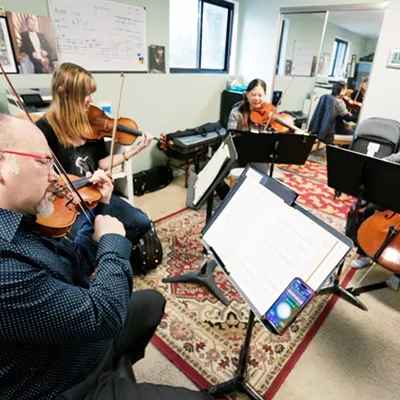The 90 minutes I spend digging camas on Bureau of Land Management land with LaRae Wiley and two of her Salish School of Spokane kindergartners — Stn̓knal̓qs and Pipqs — is enough time to learn how to dig and peel and replant. It is months shorter than these kids' ancestors used to spend, when families would camp together, moving with roots and berries as they ripened. It is shorter by millennia than all the seasons camas has been gathered throughout human history, an amount of time we measure today by calling it immemorial. Always was, always has been, always will be.
Pronunciation guide to Salish and taxonomic words, in order of appearance:
Stn̓knal̓qs: sten-kn-all-kes
Pipqs: pip-kes
itx̌ʷa: it-wah
c ́x̌ʷlúsa: tsa-whul-oosa-uh
cammasia quamash: kuh-ma-see-uh kwa-mash
lomatium cous: low-mat-ee-um coos
anticlea elegans: an-ti-klee-a el-e-gons
pi̓ča: pee-tcha
limlmtx: leem-lumpt
Since time immemorial, camas has grown in the bottomlands west of the place we currently call Spokane, and the people of the Spokane, Kalispel, Coeur d'Alene, and Colville Confederated Tribes have dug its roots. They used to be gathered mostly by women and children, but that "wasn't a steadfast rule," LaRae says. "It was more like 'divide and conquer.'" Camas is said to have provided as much protein to indigenous diets as salmon did; in Ancient Pathways, Ancestral Knowledge, ethnobiologist Nancy Turner writes that roots and berries probably comprised 70 percent of what Interior Plateau peoples ate.
The camas we dig on this mid-May day will be cooked slowly in crockpots until the bulbs are soft and caramelized. It will show up at snacktime and have a ceremonial role in school events and root feasts. Sometimes, if the camas has been pit-baked — an ancient process Turner calls "the original slow cooking" — the school will serve it cut in bars and garnish the top with moss from the pit. The camas tastes kind of like sweet potatoes, LaRae says. The moss tastes sort of like licorice. For most Salish School kids, it will be a treat, not a staple.
Digging the camas isn't just a nice day in the sun. Digging — the practice of it, the watching of fields for the right day to dig, the coming back to dig over time — creates and maintains a relationship with land, plants, and animals in a cycle of nourishment we might now call permaculture or some other English name, though these practices were here long before English was. This is true across the Pacific Northwest, for all the tribes and all the roots they dug and dig — too many roots and tubers with so many names in so many native languages, I couldn't hope to accurately recount all of them. For now, I'll stick to itx̌ʷa. Camas.
(A quick note on Interior Salish: when LaRae says itx̌ʷa, it sounds like it-wah, with an airy whoosh where the syllables join. When Stn̓knal̓qs and her mom, Emma Noyes, say itx̌ʷa, it sounds like ee-twah. When I say itx̌ʷa, it sounds like it-wa. With itx̌ʷa and other Salish words, we're all learning here. When I stumble, I imagine LaRae telling me to do my best.)
In English, itx̌ʷa is called blue camas or brown camas, or just camas. In scientific taxonomy it is called cammasia quamash and considered a member of the asparagus family. Itx̌ʷa's leaves are long and thin and emerge from the base of the plant. From those slender camas leaves, a single stalk rises a foot or so from the ground, and on that stalk, clusters of purple flowers bloom. Seen en masse at a distance, the flowers look blue.
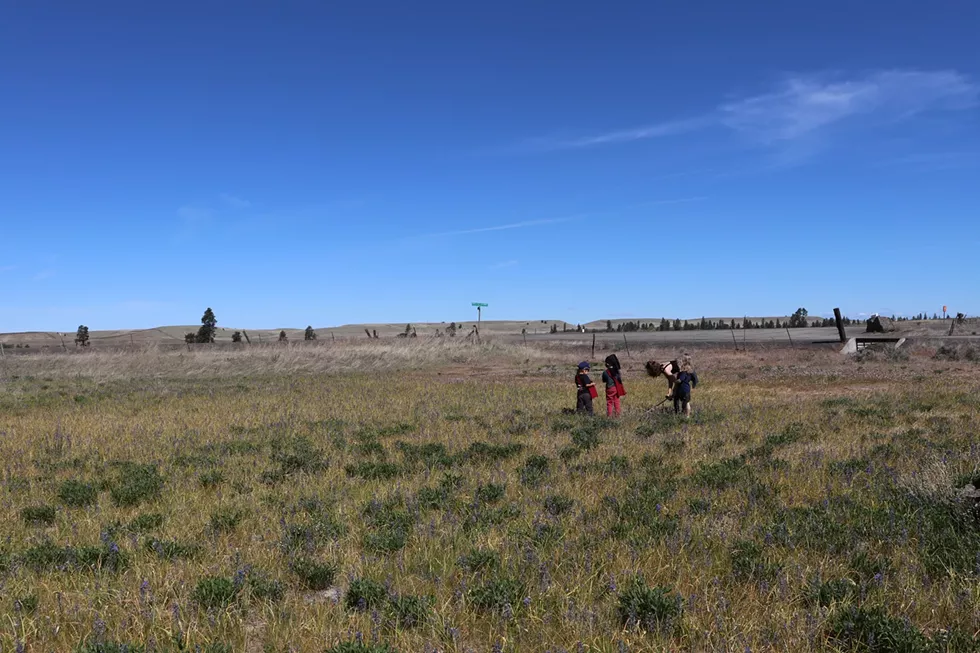
The root that Emma Noyes grew up digging is not itx̌ʷa, though she still called it camas. It's also known as white camas or biscuitroot, as c ́x̌ʷlúsa in Interior Salish, as lomatium cous in taxonomic Latin, or as Indian celery in regional American English. It has a white, umbelliferous flower, like Queen Anne's lace. Gathering white camas, like gathering blue camas, is "such a process," says Emma. "There's digging. There's having your lunch out there. There's cleaning roots for hours and hours and hours. You pull off the dark skins, and it's just this glistening watery white root underneath. It's so beautiful. They are in all kinds of different shapes. Some look like little bodies or like silly things with antennae, or have super teeny tiny roots, and bigger ones."
"White camas" is also a name for death camas or anticlea elegans, a member of the trillium family whose white flowers are toxic, as are the bulb, stem, all of it, and must not be confused with biscuitroot or the blue/brown camas that blooms in the same fields. In the Idaho panhandle, the Kalispel can dig blue camas after it has finished blooming because there is no death camas in those fields, LaRae says, but here in the Scablands, she must take her students digging while the blue camas blooms so they can tell the difference between what is food and what is poison.
When we walk off the road and into the camas field, I feel like I'm trespassing. Or, perhaps more precisely, like I'm entering a place I've only seen from car windows and have assumed is a horizon to drive past, not walk into. The blue haze on the hills right now — I've seen it before, but never noticed it. The flowers look like water, or like the promise of water, a mirage the eye can't shake. Early explorers made this same comparison when they first saw camas beds. Meriwether Lewis wrote, "From the colour of its bloom and at a short distance it resembles lakes of fine clear water, so complete is this deseption that on first sight I could have swoarn it was water." In this case, the camas we're digging really is a promise of water — just over the ridge, there's a lake.
LaRae carries a pi̓ča, a digging stick. She gives me one, too. Traditionally, pi̓čas are made with mock orange wood that has been hardened in fire. This was made of metal by one of LaRae's elders. It's about three feet long, pointed and curved at the end, with a crossbar handle at the top. To start the dig, LaRae gathers her eight students and two teachers into a circle and leads them in a song. Then she positions the tip of her pi̓ča about three inches from the base of a camas bloom and angles it in, pressing down and wiggling the stick to loosen earth. She repeats this process in several spots around the camas until clods of dirt pop free and she can lift the camas from the disturbed ground. She squats, snaps it from its stem, and folds the stem and flowers into a palm-sized packet. "I was taught," she says, "that you rebury the tops, and hopefully the seeds regenerate." Peel the skin from the bulb just like it's an onion, she says. Then bury the skin and stem in the hole where the itx̌ʷa used to be. Say a prayer of limlmtx. Thank you.
This practice of prayer and thanks "comes up a lot with food and food-gathering activities, and also when you're gathering for medicines," LaRae later says when I ask if these prayers are Christian, traditional, or something else. "It's just from your heart," she says. "It doesn't have to be to anyone or anything, but it's that gratefulness." Back when she worked at the Gonzaga Prep library, she came across a historical document by a priest noting that, "'These Indians, they pray for every little thing.'" The priest didn't celebrate that as piety? I ask. "I think they were shocked that our people were so grateful for everything and that they made it a point to give thanks before taking anything," she says. Also: "Sometimes our prayers can be very long."
LaRae stashes the bulb in the flat bag she wears at her hip and stands. "Now everyone say, 'itx̌ʷa!'" We cheer like a soccer team, ready to charge the field.
As we fan out into the camas bed, the children step carefully, lifting their feet, trying not to crush any plants, so I do the same. There is enough distance between these camas to be able to walk slowly, without crushing them, but this may not be the case in camas fields elsewhere. Climate, elevation, precipitation, competing plants, and whether or not the camas has been sustainably harvested will change how lush or sparse each field is. At this point in the season in this particular field, the plants are abundant and the ground is fairly dry and hard. The camas flowers are withered but still purple enough to let us confidently identify each bulb. Even so, my first attempts yield nothing but broken leaves. "You have to go deeper than where the bulb is," LaRae says. "You'll learn as you go. You come out every year and you get better every year."
I try again, breaking dirt and uprooting stems, trying to get the hang of using my upper body so I don't hurt my back and don't dig too shallow, hoping a little muscle memory will kick in and help me out, until finally — itx̌ʷa! The bulb is firm, white under a layer of dirt, like garlic. Camas can be selected and bred to divide like garlic, I later read. Some historians think this is how Coast Salish tribes created the ultra-productive camas beds that explorers and early settlers observed before taking the plots for their own farms. The bulb in my hand hasn't been selected for that trait, and increasing camas productivity isn't today's priority. What we do today we do in the shade of the 1883 Code of Indian Offenses, which outlawed religious and cultural practices, including the camas dig. The penalties for practicing traditional medicine, funeral rites, dances, plural marriage, potlatches, and other keystones of native culture ranged from denial of rations to imprisonment. Those basic rights weren't officially restored until the American Indian Religious Freedom Act of 1978. "To continue these gathering practices, we had to sneak to go and do them," Melodi Wynne of the Spokane Tribal Network tells me. "The broader knowledge was held in secret, and not everyone got to be a part of what was going on. The revival of these practices is where we're at right now, bringing that out into the wider knowledge base."
The tribes have the right to dig on BLM land, but that doesn't mean they dig whenever they want to, or that they can find enough camas for everyone to dig. Camassia quamash grows at Turnbull Wildlife Refuge, a gathering site since time immemorial, but to dig there, Melodi says, she has to have special permission. "To me, that's something I will eventually pursue, but for right now, I have to figure out how to swallow that insult." She remembers digging at Turnbull with some Coeur d'Alene tribal members who had permission. "It was like magic to be out there," she says. "I wish we could have easier access to that."
When I write about camas, I'm writing about history, but I'm also writing about right now, and the future, and how I've seen more than I know.
LaRae and the kids visit each camas field only once every five years, to give the fields a rest. As hard as it is to find places to dig, it's even harder to find five years' worth of places. Today, most camas fields are either privately owned or on government land. Modern digging requires a relationship with landowners. Those relationships are made vulnerable by basic rules of modern landownership — as in, if you own the land, you can sell the land to whomever you want when you want to. One of the beds that the school has been digging for years was just sold. Will the new owner welcome the Salish School? Will they plant a lawn or replace the camas with wheat fields? LaRae doesn't know. The stakes of these questions can be scary: LaRae's friends recently went digging on land their family had visited for generations and were greeted by a new landowner — and his gun. Once they explained why they were there, "he allowed them to stay and gather, but it's this whole idea that Native Americans didn't use the land," and therefore settlers could claim it for their own. "I want to challenge that idea, that the land wasn't in use," LaRae says. "That land was our ranch."
Landowners like Beth Robinette of Lazy-R-Ranch have helped. She invited the Salish School to gather camas and tules on her family's land near Cheney this year, and she's exploring whether some of her land can support camas beds while also feeding the cows she raises for beef. She's hopeful that, with the help of those cows, she can make nurturing the camas beds into a serious management objective for the ranch. "We think of livestock as a tool to optimize ecosystem function," she says. "For example — and I still don't know all of this for sure, but this is my hunch — I think after camas has set seed and gone into dormancy, it may be pretty safe, in a careful way, to graze an area that has camas for a controlled duration. That allows you to knock back competing grasses, mulch them into the soil, make sure you have nice solid soil cover. Cows are composting machines — they turn grass into manure, which contains nutrients for plants."
This is a stark shift from historical ideas about ranching, where cattle freely compacted, eroded, and polluted the root fields. The roots that survived this disturbance were starved for water and harder to dig. The consequences were catastrophic to Native diets, and sometimes violent. Turner, the ethnobiologist, writes that in the Wallowa Valley, the Nez Perce War of 1877 is said to have been sparked, at least in part, when cattle destroyed Nez Perce camas fields.
Another possibility, one that doesn't depend on the vicissitudes of modern land ownership: plant your own camas. The Salish School has experimented with planting on their grounds but hasn't yet had much luck. "They need a particular balance of water and freezing temperatures," LaRae says, "and we're just amateurs at this." Nor do they have much land to experiment with. The school sits on Maple Street about four miles north of downtown Spokane and the Spokane River, in the middle of an urban residential neighborhood. (In this country, the Salish School is one of only a few immersion Native language schools located in an urban setting.) Their school building is a repurposed house; portables sprout yearly around the original building. But there is open space, and lots of traditional food gardens with sarvisberry, chokecherries, elderberries, and more. There could be room for more. Imagine it: A camas field in the middle of a city. In the middle of Spokane.
Meanwhile, the Spokane Reservation is about an hour northwest of the Salish School, in rural Stevens County. Melodi would love to plant camas fields there. "We're super grateful that we were able to keep our own reservation and have it within our original territory," she says, "But it is the rockiest corner they could find to send us to. There's not a lot of places there where we could plant brown camas. There are places within our original territory where it would grow."
Regardless of who owns the land and who has permission, "Our plants are related to us," says Melodi. "They have their own being, their own spirit, and they want to be in relationship with us. When we're not out there getting them, they get lonely and fail to thrive. Just like we fail to thrive when we're not engaging with them. That engagement is really important. To keep going out there no matter what."
"Knowing your roots is literally knowing your traditional foods," says Emma Noyes. Growing up in Omak, she was one of many Native children in her school, but the only kid who had camas in her lunchbox. Her grandaunt/mentor, Jeanette Timentwa, loved to tell a story about how, when Emma was little, she'd jump rope in the camas fields, dig awhile, then jump more rope. Today, camas is an important motif in Emma's visual art — when she gives me directions to her house, she tells me to look for the camas painted on her front door — and she has enough camas in her pantry to be able to snack on it when she's stressed. "It's my Indian nerve pill," she says, which is what Jeanette used to say about camas, too.
When Emma's dad, Stephen, returned home to Omak a few years before Emma was born,
Jeanette took him under her wing. He'd gone through a lot — "layers and layers of trauma, including being a Vietnam vet and living pretty disconnected from his homeland, people, and culture," says Emma. As part of his healing, he had stopped drinking. He wanted to spend time helping his elders and learning their traditions. Jeanette was a leader in the Native American sobriety movement, and she put him to work. "Her main thing was the foods. That's the core of who we are — the relationships that exist within the land that we belong to," Emma says. As she grew up, Stephen and Jeanette taught Emma how to dig and host root feasts. Now Emma and her husband, Jake, are teaching Stn̓knal̓qs. Narcisse, their youngest, was born last December. Emma hopes they'll be able to camp as a family someday soon and gather roots over multiple days. Like Emma and Stn̓knal̓qs, Narcisse will never not know how to gather traditional foods.
"We're taught that if we don't go out and gather those foods, they will leave. They won't be there for us," says Emma. "There is an equal weight of responsibility on the foods and our attentiveness in gathering them." There's also an attentiveness that's key to preparing the foods. "You're not going to test kitchen them," Emma says — which isn't to say that innovative and new preparations aren't being tried wherever there is camas, just that Emma feels that one can have a sense of what's appropriate to do with camas. One of her favorite preparations is based on an old recipe. She cooks the camas, smashes it flat, drizzles it with honey, and dries it. "I grew up in the Okanogan Valley, so you could easily dry camas on a windowsill. Imagine a place drier than Spokane," she says. "It exists!" These camas crisps are sweet and carby — "comfort food," Emma says. Traditional diets didn't have many carbs. "Camas were our carbs."
I first learned about Emma through her book, Baby Speaks Salish, an illustrated primer inspired by her family's efforts to learn Interior Salish. Clearly, language is important to her — but it isn't the only thing her community should value, she says. "I've met a lot of people who can perfectly pronounce "c ́x̌ʷlúsa," Emma says. "I grew up calling it just 'camas,' or 'chocklosa,' which is a Euro/bastardized way of saying a Salish word. But if you haven't actually dug it and cleaned it and know how to take care of it, it doesn't matter how well you can pronounce it."
The places where I grew up were named after Europeans, the Native people they displaced, or the plants that grew on the land before settlers plowed it into houses and roads. Vancouver, Clark. Cowlitz, Klickitat. Brush Prairie, Camas. There was a Battleground, too. If I was taught who the battle was between and when it was fought, I can't remember. The only direct remnant of the conversation I can't remember is on the back wall of a coffee shop near Battleground High School, where a mural of a Chinookan man and a 19th century federal soldier depicts them clinking diner mugs in friendship.
When I tell LaRae about Camas, Washington, the mill town upwind of my Vancouver hometown, she says, "It's funny in our language because there's places that are just named 'It Has Camas' or 'It Has Bitterroot.'" Which means it's possible that Native names for what is now the city of Camas might not be so far off from what settlers named it, too.
I've never seen camas beds in Camas, but I've never looked. The cynical/guilty part of me says all the camas is gone, settlers destroyed everything. Just like boarding schools split families, silenced language, and stilled dances; just like the US government replaced traditional territory with lottery allotments, salmon and chokecherries with white flour and commodity cheese. All those things happened, and yet — there are still camas beds. People still speak Salish in Spokane. What I mean is when I write about camas, I'm writing about history, but I'm also writing about right now, and the future, and how I've seen more than I know — how, if you're like me, you've probably seen more than you know, too. Are there camas beds in Camas? I don't know. They grow regardless of my knowing.
When I write about camas, I'm writing about history, but I'm also writing about right now, and the future, and how I've seen more than I know.
Back in the camas field, we rest a little. Stn̓knal̓qs and Pipqs try to teach me how to say butterfly. It's "[Salish]," says Pipqs. "No, it's [slightly different Salish]," says Stn̓knal̓qs. "I say it [Salish]," says Pipqs. Repeat it for me? I ask. I say it back. "No!" they say, "like this!" I try again. "No!" I try again. "No!" they say.
This field trip isn't a break from class, but an outgrowth of the class time the kids spend learning traditional stories and talking about plants. One could think of this camas digging as a lesson, but it is not separate the way an algebra lesson is separate from a grammar lesson. "We talk about plants all the time. Like, if we're on walks, we'll talk about the different plants that are there and what their names are, what they do, when they flower. It's all in the language. It's all tied together," says LaRae.
"So many people have lost that connection to our land and foods. But our kids are really comfortable on the land, and with gathering. The parents might feel kind of nervous — 'Oh, are we going to get into trouble? What's going on here?' — but the children know this is OK, this is safe. They know what to do. The kids will teach the parents." In this way, traditional foods complement the Salish School's curriculum, where, in addition to offering an immersion environment for K-12 students, they also offer Salish lessons to the community. Parents commit to attending at least 60 hours of these classes per year. When kids come home with new words, they can practice them with their parents and vice versa, and language-learning continues — as it does in all homes — as an exchange across generations.
The Salish School of Spokane's annual dinner and drinks fundraiser is live and in person for 2022. Doors open at 5:30 pm (dinner starts at 6 pm), Saturday, Nov. 12, at Gonzaga Prep's Student Center, 1124 E. Euclid Ave. Email info@salishschoolofspokane.org for tickets.
When I first moved to Spokane, I attended a talk that LaRae and her husband, Chris Parkin, gave about their life stories and how they founded the Salish School. At the end of the program, a person near the front asked a question they hear a lot, something along the lines of, "If native Salish speakers are dying out, how do you know you're speaking Salish correctly?"
LaRae and Chris answered in Salish and in English. They said the language is living, that it changes. We aren't going to get it exactly as our ancestors did. What matters is that we speak it today. To our families. Our community. Our city. The language is us, and it changes with us. It's OK that it changes.
"I'll just tell you a dream of mine," Melodi says.
"We'd have a two-week-long camas camp, and the young people can come out and dig and dig and dig, and the elders can sit there and talk and laugh, and someone would be cooking for the camp, and we'd get a good amount of that root so it can be on people's plates on a daily basis, and we could be assured that it was healthy for us, and not toxic because of runoff from wheat fields."
Melodi doesn't expect people to go back to the old ways, but she does hope that they can look at what their ancestors did for millennia that kept them strong and healthy, then look at what they have today, "pick up what exists, and do the best that we can to be strong and healthy again." She'd love to have a teaching kitchen with space to store preserved traditional foods. A place where people could prepare the bulbs and other traditional foods for winter storage, and just be together. Like the old days.
What would it take to make that happen? I ask.
"Money," Melodi says. "Partnerships, too. Within the tribe so that the departments are working together, and partnerships outside of the tribe, like with Beth [of the Lazy-R-Ranch], where people are like, 'Come in the spring and look at the place, I know I have stuff growing here.'" She wants "accomplice relationships with non-Native people. Co-conspirators. Let's work together because it's important for all of us," she says. "We have a lot of non-Native people who show up and want to help us. We don't need help. We need them to realize their liberation is bound up with ours."
Melodi's dream sounds, to me, a lot like LaRae's: "I want people to have an open mind about sharing where things grow and why they grow there," she says. "To be open to, for example, letting our students come and dig itx̌ʷa on their property, or c ́x̌ʷlúsa, or pick serviceberries. To be open to the idea of — I know it sounds kind of crazy, but — the land being for everyone. Most people of color have been pushed off the land and don't have access to spaces. So that's really my hope for the future: that we can create more spaces for people to gather, to be." As their ancestors were, as their children are: in the camas beds, digging since time immemorial. ♦

